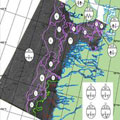From climate change monitoring to supporting humanitarian aid and crisis situations, early data applications from the month-old Sentinel-1A satellite show how the radar mission's critical observations can be used to keep us and our planet safe.
From climate change monitoring to supporting humanitarian aid and crisis situations, early data applications from the month-old Sentinel-1A satellite show how the radar mission's critical observations can be used to keep us and our planet safe.
Launched from Europe's Spaceport in French Guiana on 3 April, Sentinel-1A is the first satellite in Europe's Copernicus environmental monitoring network. The mission uses radar to provide an all-weather, day-and-night supply of imagery of Earth's surface.
At an event in Brussels today, experts who had been given access to early Sentinel-1A radar data presented how a variety of operational and scientific applications will benefit.
"These [radar] images and their analyses will benefit European citizens, enterprises and decision makers, as well as the international scientific community. They will allow us to better protect our planet and improve the quality of life of our citizens," said Philippe Brunet, Director of Aerospace, Maritime, Security and Defence Industries at the European Commission.
